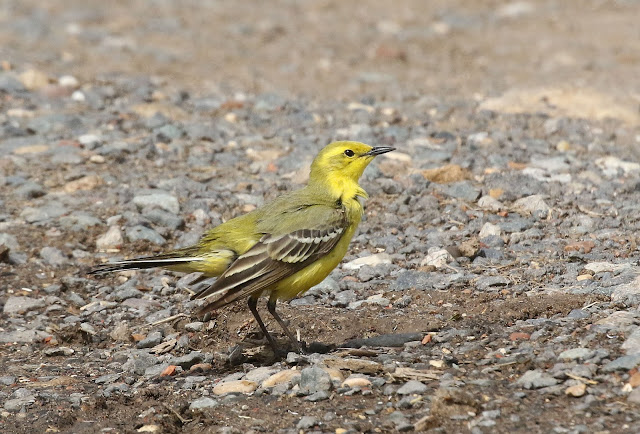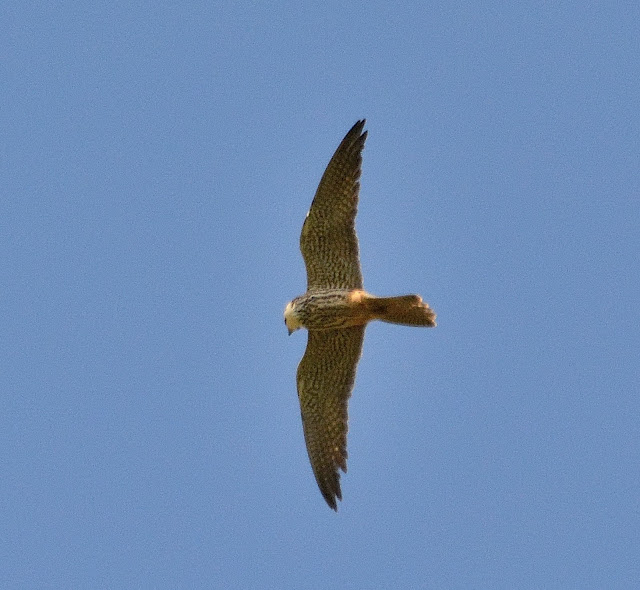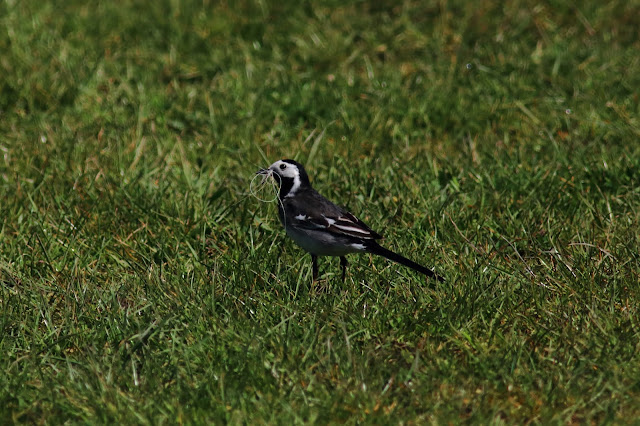On Tuesday we returned to a quiet, if untidy part of the country. From the car park are we could hear a very distant Cuckoo, and that was to be our only encounter with this once guaranteed species at this location. Swallows and Linnets were flying over the abandoned construction site. We set off, but found very little around the fishing lake, just a Moorhen and we heard a Little Grebe. The walk between the lakes to the hill produced a Chiffchaff, Chaffinch and Long-tailed Tits. The Monty Python path was punctuated by calls of a few Reed Warblers, a Sedge Warbler, a Whitethroat, a Reed Bunting and more Linnets. When we emerged from the path we had a close fly-by from a Lapwing. On the sporting lake we saw a Mute Swan on a nest and a Great Crested Grebe isolated on the lake. A Heron flew over our head, but we couldn’t spot anything at the heronry, this distance away. We walked to the bridge and saw at least 3 Marsh Harriers, which was the best sighting of the morning. We finally walked along the old railway line, where the best bird was a puppet-on-a-string Whitethroat. The group encountered 31 species, which brought the cumulative figure for the term to 81.
Lapwing
Female Marsh Harrier
Male Marsh Harrier
ditto
Reed Warbler
Whitethroat
ditto
Jackdaw
ditto
Rudd? or Roach?
ditto
In the afternoon I managed to photograph a Skylark from a small lay-by, and a Linnet and stunning Yellow Wagtail from a roadside puddle.
Skylark
ditto
ditto
Yellow Wagtail
ditto
ditto
ditto
ditto
Male Linnet
Female Linnet
On Wednesday many of us arrived early, and from the car park it was possible to hear the Cuckoo, Cetti’s Warbler and a Grey Wagtail left the water treatment centre. We walked up the bank and almost immediately a small flock of around 6 Bearded Tits dropped into the reedbed in front of us. They were much trickier to gain good views of as it is in the Autumn. Along the path we heard various Reed Warblers and then Sedge Warblers. The latter were relatively easier to see. We hadn’t been walking long when a brown bird was spotted flying towards us, this proved to be a Bittern. Later, we heard booming on several occasions, possibly of two birds. The Cuckoo also fly past us on a few occasions, but when it alighted it was nearly always on the verge of sight.
Bearded Tit - crossing the path
ditto
Cuckoo (c) 2021 Tony Robinson
Sedge Warbler
ditto
Bittern
ditto
ditto
Bittern (c) 2021 Tony Robinson
ditto
Reed Buntings were probably the most obvious bird seen with Linnets maybe coming a close second. However, these were all eclipsed audibly by the almost permanent and deafening Cetti’s Warblers. We tended to get only glimpses of these as they moved from bush to bush, usually using the back route!
Reed Bunting
ditto
ditto
ditto
Reed Bunting (c) 2021 Tony Robinson
When we had travelled some distance we reached a flooded field. A Little Egret was joined by a Great White Egret, and on the way back several Spoonbills had also joined this group. After lunch the field contained several Black-tailed Godwits, with one specimen being very brightly coloured. Nigel also picked out an Egyptian Goose near one of the Mute Swans. When we reached the locked hide again, it was great to see 3 adult Spoonbills busy feeding right at the front of the water. This was possibly the best sighting of Spoonbill we had ever seen.
Spoonbills
ditto
ditto
Spoonbills (c) 2021 Tony Robinson
Male Shelduck
Record shot of Swift
Yellow Wagtail
ditto
Black-tailed Godwits
Dunnock
We saw several large fish in the murky water. Mike's experience and research leads us to believe these may have been Chubb. We also saw a 'Jack' Pike, but the photo isn't good enough to reproduce.
Chubb (c) 2021 Mike Hind
Halfway along the main path in the afternoon we saw two distant raptors around the pylon wires. Although they were distant, it was possible to see that they were falcons, and the tail length for the size of the bird was fairly short, so Peregrine was the most likely candidate. Later, we saw two very dark small falcons in the lee of the hill. One of them seemed to drop its talons as if it was catching something in mid-air, and I thought I discerned an orange hue around the underside of the tail area. Sure enough the photos showed that these two were Hobbies.
Peregrine
Hobby
ditto
The morning session encountered 54 species, and was the most successful visit of the term so far. The course species total has increased dramatically to 82. Some of the Weds am crew dropped in to Ness End on their way back. They heard several booming Bitterns, and enjoyed their best ever views of 2 Hobbies over the reedbed. A Common Tern was a first of the year for those who went.
Hobby (c) 2021 Tony Robinson
ditto
ditto
ditto
ditto
ditto
ditto
ditto
dittoCommon Tern (c) 2021 Tony Robinson
Heron (c) 2021 Tony Robinson
ditto
ditto
ditto
ditto
ditto
ditto
ditto
dittoCommon Tern (c) 2021 Tony Robinson
Heron (c) 2021 Tony Robinson
ditto
On Thursday we walked along the River Hull. We had Sand Martins, Starlings, Rooks and House Sparrows near Hull Bridge House. The weather was beautiful, but at first the bird life seemed rather quiet. The fringe of reeds resulted in both Reed Warblers and Sedge Warblers. There were plenty of Rooks, Crows and Jackdaws on the pasture, but smaller birds seemed harder to find.
Reed Warbler
Meadow Pipit
Lapwing showing purple iridescence
Swallows and Sand Martins were flying around, and Rose spotted a soaring Sparrowhawk. We noticed the unpleasant noise of Marsh Frogs at various places. On the return journey along Barmston Drain we saw our first Swifts, and shortly after Elwell’s Bridge a pair of Yellow Wagtails dropped in, and we had just started to walk again when Peter noticed a pair of Wood Sandpipers in a shallow marshy area. We managed prolonged views of this dainty wader. This was undoubtedly the bird of the morning. They had gone in the afternoon, but we did enjoy two views of a flying Common Sandpiper. Apparently, if we had gone to Swinemoor a few days earlier we may have seen a summer-plumaged Red-necked Phalarope. After lunch a large influx of House Martins had appeared, but the other hirundines and Swifts were still present.
Female Great Spotted Woodpecker
ditto
ditto
Female Pied Wagtail collecting nesting material
ditto
ditto
Pied Wagtail (c) 2021 Paul Green
Record shot of female Sparrowhawk
ditto
Swallow
Sand Martin
Swallow and Sand Martin
Lesser Whitethroat
Mallard Brood
Yellow Wagtail (c) 2021 Paul Green
Wood Sandpiper (c) 2021 Paul Green
Wood Sandpipers
Wood Sandpiper
Gordon spotted a surprise after lunch: a tern with a small fish in its bill.
Common Tern
ditto
ditto
ditto
ditto
Common Sandpiper
Azure Damselfly?
Two Dumb Clucks after being knee-deep in the morass since rescuing their pampered pooch. Apparently, they virtually threw it to the ground once they had reached dry land. Moral: Keep your dogs on a lead!
On Friday we met at Millington. It was very overcast and it drizzled at times. The Blue Tit was up to its old tricks in the car park. There weren’t as many singing birds on the way to the pond, but we did hear Willow Warbler, Whitethroat, Red-legged Partridge and Blackcap. As well as small fish (minnows?) there were quite a few tadpoles in the shallow water. On the walk up the valley we heard another noisy Red-legged Partridge, but we failed to locate it among the scrub. Linnets sang merrily at times, and Pat spotted a Yellowhammer. The walk to the old Yorkshire Water compound didn’t produce as many species as usual, but we saw another Yellowhammer. The trek through the wood produced at least 2 singing Treecreepers, a Great Spotted Woodpecker flew over us, and a pair of Blackcaps were waiting for us near the gate. Some movement behind an elder bush resulted in a sighting of a dying Buck Roe Deer, which Jane protected by asking a bloke with two free-running dogs to put them on a lead when they neared the point where we had seen the deer.
Blue Tit (c) 2021 Jane Robinson
ditto
Whitethroat (c) 2021 Jane Robinson
The afternoon was slightly warmer and the birds were quite similar, although Sarah spotted a Red Kite as it passed overhead. For many years I’ve been contradicting the Christmas carol which mentions ‘And a Partridge in a Pear Tree’. I said this was highly unlikely as I’ve never seen one in any species of tree, and moreover would never do so. However, newbie Dave soon disproved this theory by pointing out one calling from a tree, and thus the week ended!
Red-legged Partridge in an Ash Tree
ditto
Tadpoles
Tadpoles (c) 2021 Jane Robinson
Toadstools















































































































No comments:
Post a Comment